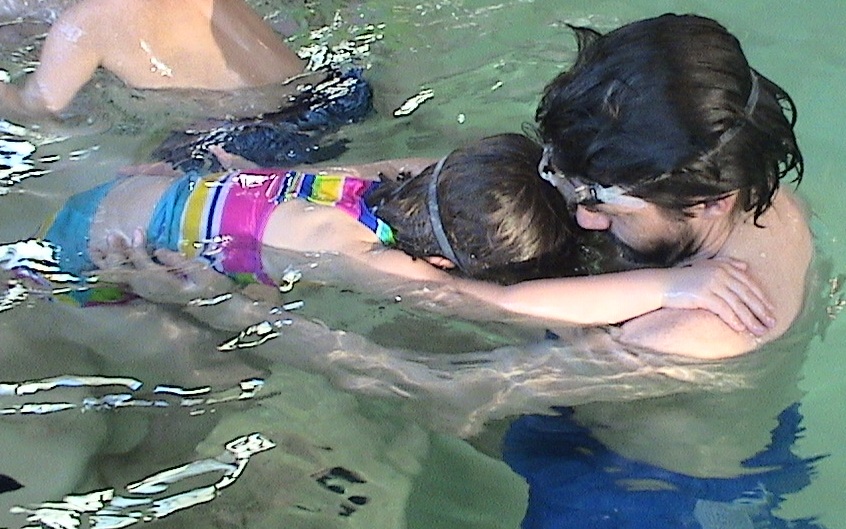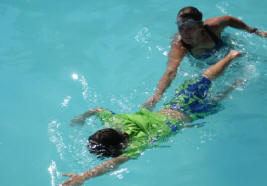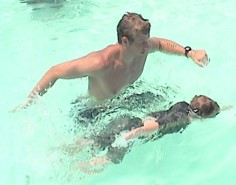New students should continue reading below before reviewing policies and enrolling.
Behavior expectations, makeup class policy and more can be found here.
Returning students can go directly to the enrollment page.
Curriculum Overview
We offer swim instruction for ages two to adult.
Personalized Swim Instruction© is a curriculum designed for ages four* to adult and offers a spectrum of aquatic education from survival to swim team preparation. One of the most unique aspects of our curriculum is that even while teaching our young students the basic techniques needed for survival, we are integrating the correct techniques for competitive swimming.
Our curriculum objectives are: 1) Equip students with the skills to survive in a water-related emergency; and 2) Develop and refine practical safety and swimming skills, which will provide students with the self-confidence needed to safely enjoy the aquatic environment.
*Ages 2 to 3:
Our standard group class environment is very structured and therefore best suited for children age four and above. However, we can make an exception for three-year-olds who: 1) are within 6 months of their 4th birthday at the time of the session; 2) are prepared for our class environment and well suited for our behavior expectations; 3) have experience in a structured group setting such as preschool or have participated in other group classes. Please contact us to discuss your child’s readiness.
If your child is not old enough and/or ready for our standard group classes, we offer one-on-one and exclusive group classes. In an exclusive group class, you can determine the number of students from your family and/or friends. For your scheduling convenience, this exclusive group could also include older siblings. For some of these arrangements, we may require one or more parents to be poolside or in the pool with the student(s). Please contact us to discuss these options in more detail and create a personalized experience for your child(ren).
Ability: Degree of Autonomy (Measured in Distance)
Ability 1

Ability 2

Ability 3

Ability 1
Criteria: The student is cautious or has a fear of the water. The student will not move through the water to the instructor without “Buoyancy Support” from the instructor. Buoyancy Support means that the instructor holds the student’s abdomen, providing buoyancy assistance, as the student attempts to perform \ assimilate multiple Thematic Movements. Thus, the student’s ability of autonomy, as measured in distance, is 0 feet.
Focus: The focus of Ability 1 is to instruct students in basic safety; and in the proper motor skill coordination for swimming Freestyle and floating on the back. For Ability 1 students, all activities are done with total Buoyancy Support from the instructor.
The students are introduced to Freestyle: Buoyancy Control, Breathing Control, Kicking (leg movements) and Pulling (arm movements). Throughout each session of lessons, the students learn to assimilate these Thematic Movements together to perform the Freestyle stroke with Buoyancy Support from the instructor. Each student also learns and recites safety rules.
The goal is to enable students to perform these skills with minimal Buoyancy Support and eventually without the Buoyancy Support of the instructor.
Ability 2
Criteria: The student can move through the water at least 10 feet without Buoyancy Support from the instructor.
Focus: In addition to the skills listed for Ability 1, the students perform “Gliding” without Buoyancy Support. This Frontglide (Buoyancy Control + Breathing Control) eventually develops into an attempt at Freestyle as students assimilate Kicking (leg movements) and Pulling (arm movements). The end goal for Ability 2 is that the students swim Freestyle for 25 feet (8+ yards) with good technique. Good technique is defined by specific criteria on the Student Ability Report, which each student receives on the final day of class for each session.
Students are introduced to very practical safety skills. These include Backfloat (floating on the back without Buoyancy Support from the instructor) and our Self-Rescue Plan for Short Distance. This self-rescue plan has two phases. Students jump into deep water, in which they fully submerge. They learn to take a quick breath and exhale from their nose as they enter the water. They learn to pull themselves back up to the surface and take a quick breath. In the first phase, students attempt to arch into an autonomous Backfloat. While attempting to Backfloat, they call for help. In the second phase, students search for the wall, take a breath and swim Freestyle back to the wall. Many parents have told us that these skills have made a critical difference when their child(ren) have ventured too far from the edge of the pool. The students are also introduced to practical and basic Peer Rescue Skills.
Ability 3
Criteria: The student can move through the water at least 30 feet without Buoyancy Support from the instructor.
Focus: The focus for Ability 3 is that the students refine Freestyle for the purpose of aquatic enjoyment. The end goal for Ability 3 is that the students swim Freestyle for 75 feet (25 yards) with excellent technique. Excellent technique is defined by specific criteria on the Student Ability Report, which each student receives on the final day of class for each session. To accomplish this, students learn to extend the shoulder and back, thereby causing a “body roll” that permits lateral breathing and enables them to swim longer distances.
We continue to emphasize safety via our Self-Rescue Plan for Long Distance, in which the students learn how to transition between Freestyle and Backfloat. The students learn to roll over from Freestyle to a Backfloat. While backfloating, they learn to stay calm and control their breathing rate. When they have had sufficient rest, they roll back over and continue swimming. Successful implementation of this safety plan allows the students to swim longer distances by resting in a Backfloat as necessary. Many parents have told us that this safety plan has given their child(ren) the self confidence needed to feel comfortable in the water and enjoy going to the pool or swimming in supervised open-water settings.
Level: Degree of Proficiency (Technique while Traversing the Distance)
A
Performance of Individual Thematic Movements: “Buoyancy Control,” “Breathing Control,” “Kicking” and “Pulling” are the four Thematic Movements that comprise the essential components of every stroke. A “Level A” student is working toward performing, or may successfully perform, individual Thematic Movements in isolation but cannot yet successfully assimilate multiple Thematic Movements.
B
Simultaneous Assimilation of Two Thematic Movements: Before the student can assimilate all of the Thematic Movements itemized in Level A above, he/she must first begin simultaneously assimilating different combinations of two Thematic Movements. A “Level B” student is 80% successful in performing all individual Thematic Movements in isolation (thus has graduated from Level A) but cannot yet successfully assimilate the various combinations of two Thematic Movements. Thus, they are working on Level B criteria.
C
Simultaneous Assimilation of Three Thematic Movements. A “Level C” student is 80% successful in assimilating two Thematic Movements (thus has graduated from Level B) but cannot yet successfully assimilate the various combinations of three Thematic Movements. Thus, they are working on Level C criteria.
D
Simultaneous Assimilation of Four Thematic Movements:At this level, the student is now assimilating all of the information learned into one focus – Swimming! A “Level D” student is 80% successful in assimilating three Thematic Movements (thus has graduated from Level C) but cannot yet successfully assimilate the four Thematic Movements with a demonstration of excellent technique. Thus, they are working on Level D criteria.
E
Student demonstrates 90% proficiency of a given stroke (Freestyle as related to this specific table). A “Level E” student is 90% successful in assimilating the four Thematic Movements and thus has graduated from Level D.
A student with an Ability Level of 1D has demonstrated the ability to assimilate all four Thematic Movements for Freestyle (proficiency Level D), but is not yet able\willing to do so without Buoyancy Support from the instructor (autonomy Ability 1). In other words, even though the student cannot yet swim autonomously, he/she is basically doing a “stationary” Freestyle stroke. This is an excellent foundation and when the student develops the courage and confidence to push away from the edge of the pool autonomously, he\she will have the “muscle memory” necessary to swim with a good level of proficiency! Conversely, a student with an Ability Level of 3A has demonstrated an ability\willingness to “swim” (move through the water) at least 30 feet autonomously (autonomy Ability 3) but has not yet demonstrated the successful assimilation of multiple thematic movements while traversing 75 feet (proficiency Level A). In other words, he\she can “cover the distance” but has yet to do so using a proficient Freestyle stroke.
2024 Session Schedule
| Enrolling now! | Click Here to Enroll Online | |
| Spring Sessions | For each "session", you may choose Mon & Wed or Tues & Thurs for 3 weeks | Class Times - All PM |
| Session 2 | Mondays & Wednesdays April 8 - April 24 | 4:15 to 4:50; 4:50 to 5:25; 5:25 to 6:00; 6:20 to 6:55; 6:55 to 7:30; 7:30 to 8:05. *8:15 to 8:50 or 9:25 - see below |
| Session 2 | Tuesdays & Thursdays April 9 - April 25 | 4:15 to 4:50; 4:50 to 5:25; 5:25 to 6:00; 6:20 to 6:55; 6:55 to 7:30; 7:30 to 8:05. *8:15 to 8:50 or 9:25 - see below |
| Session 3 | Mondays & Wednesdays May 6 - May 22 | 4:15 to 4:50; 4:50 to 5:25; 5:25 to 6:00; 6:20 to 6:55; 6:55 to 7:30; 7:30 to 8:05. *8:15 to 8:50 or 9:25 - see below |
| Session 3 | Tuesdays & Thursdays May 7 - May 23 | 4:15 to 4:50; 4:50 to 5:25; 5:25 to 6:00; 6:20 to 6:55; 6:55 to 7:30; 7:30 to 8:05. *8:15 to 8:50 or 9:25 - see below |
| Summer Sessions | Monday, Tuesday and Thursday for 2 Weeks | Class Times - All PM |
| Session 4 | June 3 - June 13 | 4:00 to 4:35; 4:35 to 5:10; 5:10 to 5:45; 6:05 to 6:40; 6:40 to 7:15; 7:15 to 7:50. *8:10 to 8:45 or 9:20 - see below |
| Session 5 | June 17 - June 27 | 4:00 to 4:35; 4:35 to 5:10; 5:10 to 5:45; 6:05 to 6:40; 6:40 to 7:15; 7:15 to 7:50. *8:10 to 8:45 or 9:20 - see below |
| Session 6 | July 8 - July 18 | 4:00 to 4:35; 4:35 to 5:10; 5:10 to 5:45; 6:05 to 6:40; 6:40 to 7:15; 7:15 to 7:50. *8:10 to 8:45 or 9:20 - see below |
| Session 7 | July 22 - August 1 | 4:00 to 4:35; 4:35 to 5:10; 5:10 to 5:45; 6:05 to 6:40; 6:40 to 7:15; 7:15 to 7:50. *8:10 to 8:45 or 9:20 - see below |
| *Classes beginning after 8:00 pm can be scheduled individually or in partial session increments, with the option for 35-minute or 70-minute lessons. Contact us to discuss pricing and availability. | ||
| End of Summer Session | Private, Semi-Private Lessons or Exclusive Family/Friends Group Lessons on Tuesdays and Thursdays | Class Times - All PM |
| Session 8** | Tuesday, August 13 Thursday, August 15 Tuesday, August 20 Thursday, August 22 Tuesday, August 27 Thursday, August 29 | 4:15 to 4:50; 4:50 to 5:25; 5:25 to 6:00; 6:20 to 6:55; 6:55 to 7:30; 7:30 to 8:05. |
| **Classes during Session 8 will only be scheduled as private, semi-private or exclusive family/friends group lessons. The classes can be scheduled individually or in partial session increments, with the option for 35-minute or 70-minute lessons matching the posted times. Contact us to discuss pricing and availability. | ||
New to Our Program?
Please review our policies and procedures before advancing to the enrollment page.
Ready to Enroll?
You can go directly to our enrollment page.
FAQs
Your questions are answered here.
